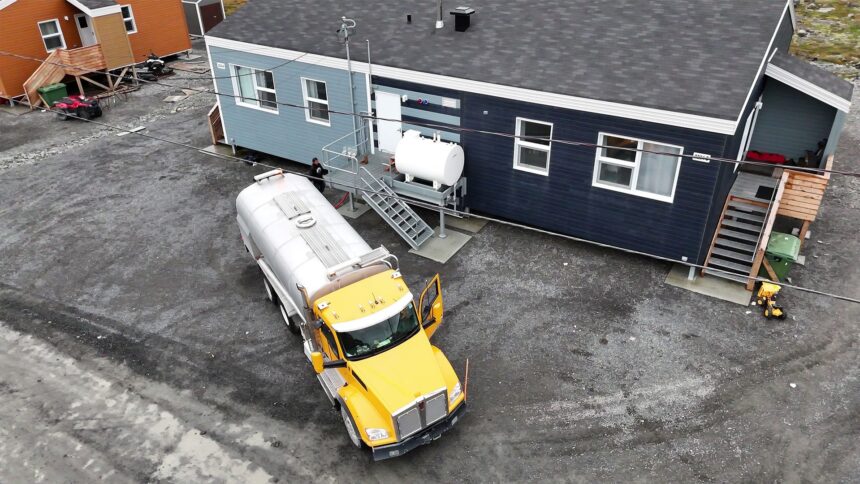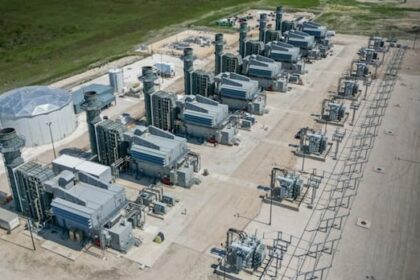Juani Qinuajuak’s walkie talkie crackles to life with a burst of rapid-fire Inuktitut. While keeping his left hand on the wheel, he grabs it off the dashboard and answers. On the other end is the receptionist from Puvirnituq city hall, giving him an address. Qinuajuak mentally adds it to the list of places he needs to stop off at before the end of his shift. In the passenger seat, his co-worker Moses Novalinga’s slight frame bounces in the seat every time the water truck hits a rough patch of gravel road, which, around here, is often. They drive in silence until Qinuajuak pulls up to a house. While he’s shifting into reverse, Novalinga slips out of the passenger side and jogs to the back of the water truck as it inches towards a couple of attached houses. As Novalinga frees the hose from the back of the truck, Qinuajuak hops out of the cab and runs back to help. Novalinga carries the hose by the nozzle up a flight of steps while Qinuajuak tugs hand over hand at the base of the hose, giving Novalinga the slack he needs to make it to the houses’ shared water tank. He attaches the nozzle, Qinuajuak flips a lever, and hundreds of litres of water exit the tank of the truck and fill up the one that provides running water for the homes. After a few minutes, the house tank is full and they repeat their choreography, but in reverse. It’s physical, repetitious, essential work. Qinuajuak says this is a good day, partly because it’s September and the weather is nice, but mainly because there are four trucks on the road. “When there’s only two trucks or one, I don’t like it because our village is getting bigger. Lots of construction, more buildings,” says Qinuajuak. Juani Qinuajuak says he fills up his 13,600 litre truck up nine or ten times a day in order to meet the water demands of Puvirnituq. Photo: Tom Fennario/APTN. Because of permafrost and bedrock, there is no underground piping to houses in Puvirnituq, an Inuit community in Nunavik, about 1,500 kilometres north of Montreal near the coast of Hudson’s Bay. So, every weekday from 7:00 a.m. to 5:00 p.m., Qinuajuak and others physically truck water from the filtration plant to individual homes and businesses. A multi-generation family living in one home will go through their water tank pretty fast. Qinuajuak says he’ll fill up his 13,600 litre truck nine or 10 times a day while delivering. He says when there aren’t enough water trucks on the road, there’s not enough time in the day to fill up everyone’s tanks. That could mean for some people, no running water to take a shower, do the dishes, or even flush the toilet. “Sometimes it’s not easy when they need water. People get angry and we work so hard,” says Qinuajuak. Mention the water crisis that put Puvirnituq in the headlines this past spring, and Qinuajuak looks exhausted at just the memory of it. “It was only three trucks running during that crisis,” explains Qinuajuak. “We had the blizzard too, when we get winter, and the road is getting very snowy or slippery.” Broken water trucks in need of repair and bad weather that can reach minus 30 are, unfortunately, nothing new this far north. But in March, water delivery went from difficult to gruelling when a pumping station on the outskirts of town had a power failure, leading to a cascading series of catastrophes. After a power failure in March, pumps in this pumping station to cease functioning, which in turn caused a pipe to burst. Photo: Tom Fennario/APTN. The backup generator didn’t kick in like it was supposed to. The pumps failed. A normally heated section of pipe froze and broke. The end result was that river water couldn’t be pumped from the station to the centrally located filtration plant for treatment and easy delivery. “It’s about half an hour ride,” says Qinuajuak of the winter drive to fill up his truck at the pumping station outside of the village. “And go back to [town] another half an hour, that’s an hour.” In May, after a three-month boil water advisory and residents going days, even weeks, without running water in their homes, a state of emergency was declared by Mayor Lucy Qalingo. “Some of the families, they had to fetch snow from outside and melt it to do their dishes and to also flush their toilet,” says Qalingo, who was elected mayor in November 2024. “When families of like, seven, are not receiving any water, it’s very tiring and very frustrating.” A drone shot of Puvirnituq, Nunavuk in northern Quebec. The community has a population of more than 2,100 and is projected to increase to 6,600 within the next 25 years. Photo: APTN. With a population of over 2,100, Puvirnituq is the second largest of the 14 Inuit communities in Nunavik, the name for the ancestral Inuit territory in the northernmost reaches of Quebec. For years, their population has been booming. About two-thirds are under the age of 30. There are a lot of kids playing in the streets and because of the lack of housing here, a lot of overcrowded homes when they go home for dinner. Infrastructure everywhere is struggling to keep up. “We do have Elders who need to be in a clean place,” says Akinisie Sivuarapik, the general manager of the Pituat Family house, a local community centre. “We have two schools in the community. Sometimes they have to close because there’s no water in the schools. It’s worrisome, we need to have a working fix to this problem.” Sivuarapik was forced to close the family house to the community for a month, depriving residents of cultural programming, meals, and other services. That’s not the only cost of having water shortages in overcrowded houses. A 2022 report put out by the Nunavik Regional Board of Health and Social Services (NRBHSS) says that insufficient water contributes to issues like diarrhea, skin infections, and respiratory illnesses, as well as psychological problems such as anxiety and depression. “This [2025] water crisis that we experience is not the only one. We’ve been going through this for so many years,” says Qalingo in exasperation. French language documents obtained by APTN Investigates show that in February 2022, a similar but less serious problem with the pipe freezing happened. Coupled with only two functioning water trucks out of five, the community went several weeks with severe water shortages. When Quebec was asked for disaster funding help to fly in a new water truck to the community, it was refused because “… cold weather is not considered a disaster in the eyes of the law.” It doesn’t end there. Water delivery issues also plagued the community in 2023 and 2024, with consistent problems not being adequately addressed. The Puvirnituq hospital, which also serves other smaller Inuit communities along Hudson’s Bay, was evacuated during the 2025 water crisis. It’s been struggling for years to maintain sanitary standards in the face of frequent water shortages. One 2024 email between health workers obtained by APTN describes four patients being given laxatives a day in advance of scheduled colonoscopies, who were then housed together in a home. Except, the email goes on to note that the home ended up having no water…leading to a disgusting and humiliating situation for the patients involving them “defecating at the same time in the toilet and the bathtub.” One major issue affecting water delivery is that the roads in Puvirnituq are not kind to water trucks, leading to constant breakdowns. As a remote fly-in community, getting trucks, or even parts, is not easy. This summer Puvirnituq got finally got new trucks, but old problems persist. “We received two new water trucks during the first sea lift, but both of them, they were not functioning well already,” says Qalingo. “They are made for highways, not for bumpy roads like our roads. I want to say it’s getting better, but I cannot promise because of the malfunctions that already exist when they come.” “If I could buy trucks from Russia, honestly, I would, because they have the best commercial line of trucks designed for this type of extreme weather,” says Hossein Shafegahti, the director for Municipal Public Works for all of Nunavik. “The trucks that are available in North America to buy in the market are designed for Texas and California and New York, you know, where there is a market.” Akinisie Sivuarapik is an accomplished throat singer and the general manager of the Pituat Family house. Photo: Tom Fennario/APTN. When it comes to water delivery, international trade sanctions are the least of Shafegahti’s concerns. He works for the Kativik Regional Government (KRG), who have oversight over the 14 Inuit communities spread across Nunavik, which is roughly the size of Alberta. In an interview, Shafegahti acknowledges a difficult truth that others dance around. The most recent Puvirnituq water crisis was caused in part by “maintenance negligence” from an underqualified individual who was filling in for the absence of the usual water treatment operator. “When there is a new operator, we do a very simple basic test to see where they stand in terms of math, in terms of science, to see where we start our training from,” explains Shafegahti. “The gentleman didn’t know the freezing temperature of water.” Shafeghati points to how properly training water operators involves Inuit leaving their communities for two years because there are no water treatment trade programs in Nunavik. It’s also important to note that many Inuit are working through intergenerational trauma, which includes residential schools, forced relocations and an RCMP-led dog slaughter. Inuit in Nunavik were, for the most part, left alone until the 1950s, so the first wave of colonialism is much closer in the rear-view mirror than for most Indigenous people in Canada. Lucy Qalingo says hiring qualified people for important jobs is a big challenge. “They just leave the jobs because of the pay rate is very low,” Qalingo explains. “It’s very expensive to be living in a region and when you have children and you’re not getting benefits, the same as the hospital workers or any other organization. Nobody wants to work for low paying jobs. “And the little money that we get from the government is not enough to cover and we’re not able to compete with other organizations.” ‘When families of like, seven, are not receiving any water, it’s very tiring and very frustrating,’ says Lucy Qalingo, who has been the Mayor of Puvirnituq since November 2024. Photo: Tom Fennario/APTN. When asked about his pay and working conditions, Juani Qinuajuak is diplomatic. “I love that it’s an every-week pay,” says the 30-year-old, who is the longest serving Puvirnituq water driver at six years. Documents and emails obtained by APTN show that, along with infrastructure issues, driver absenteeism also poses a problem when it comes to water delivery. In January 2024, the water shortage got so bad that workers at the Puvirnituq hospital began training to drive the trucks due to a lack of municipal employees showing up for work. An email exchange between public health employees describes relations between the KRG municipal works and Puvirnituq city hall as “difficult.” Saying that Puvirnituq municipal employees “never respond to emails ” when it comes to infrastructure work. The email also notes “there is no support offered to town managers to learn and do their job.” “When I went back to my position, I had to relearn how to communicate with KRG,” says Qalingo, who wasn’t the mayor for the 2022 to 2024 water shortages, but did serve as mayor before 2022. “Also, there was no town manager at the moment when I got the seat as a mayor and we had to hire from out of town to make things work.” Qalingo’s says people are often put in a position to fail, and because of infrastructure challenges, the margins for mistakes are thin. “There’s always an employment turnover. It’s not just the municipal. It’s everywhere. It’s at the hospital. It’s the school. So, we always need training,” she says. The headquarters for the Kativik Regional Government are located in Kuujjuaq, Nunavik, about an hours flight from Puvirnituq. Photo: Tom Fennario/APTN. Shafeghati describes the communication between Puvirnituq city hall and KRG under Qalingo’s leadership as “the difference of day and night” compared to the old regime. But instead of focusing on human resources and man-made error, he would like to build more resiliency. “Let’s look into it from a perspective of equity. Let’s look at the infrastructure gap that we have in Nunavik,” Shafeghati says. KRG has a budget of almost $400 million in block funding to help pay for everything from policing to internet to child care and all the infrastructure that entails. There are also additional funding agreements that can add significantly to that figure. About 14 per cent comes from the federal government and 77 per cent coming from the Quebec government. Much of that money trickles down to the communities, which are officially known as northern villages. Shafeghati explains his budget of about $200 million over four years breaks down to about $3.5 million a year per community, and since things are more expensive in the north, those dollars don’t stretch as far as they do in the south. “In terms of infrastructure, you need money. In terms of feet on the ground, you’ll need money,” Shafeghati says. “Just to optimize the trucking system and have a resilient infrastructure, this year’s money, we need something about, $120 to $130 million just for Puvirnituq.” In 2024, Inuit Tapiriit Kanatami (ITK), the organization that represents Inuit at the federal level, identified a $75-billion infrastructure gap for the four Inuit regions in Canada. They proposed a 35-year funding plan for Inuit communities to catch up with the living standards of the south. The Inuit community of Puvirnituq is located about 1,500 km north of Montreal in Nunavik. Meanwhile, the latest federal budget has announced a new $1-billion fund over four years for Arctic transportation infrastructure, but with a focus on deepwater ports, airstrips, sealift facilities, and all-season roads. Newly elected KRG Chairperson Maggie Emudluk declined to do an interview or provide a statement regarding water infrastructure in Nunavik or funding negotiations with Quebec. But during a KRG meeting in September, Emudluk said that “There are many PUVs [Puvirnituqs] waiting to happen.” It already has on a smaller scale. In the spring of 2022 a Quebec civil security report obtained by APTN states that in addition to Puvirnituq, the villages of Ivujivik, Inukjuak, Aupaluk, and Kangirsujuaq all suffered through water shortages. The document says the shortages resulted in a visiting dentist cancelling four days’ worth of appointments, resignations of health and social services personnel, as well as outbreaks of gastroenteritis, hepatitis A, and tuberculosis. “It’s been so many years that this issue has been brought up to the government. They say that they give us enough money without having the knowledge or the experience that we go through,” says Qalingo. As for Quebec, the province’s minister for Relations with First Nations and Inuit, Ian Lafrenière, also declined to do an interview. In a statement, a spokesperson says they are “sensitive” to the water issues in Nunavik, going on to add that “. . . the issues surrounding municipal services go beyond their funding. A lasting solution to this issue will necessarily involve not only the government of Quebec, but also the northern villages themselves and regional organizations.” Documents obtained through an access to information request show that Quebec and KRG are funding a study by an engineering firm to come up with a feasible replacement to the water trucks. The possible solutions are redacted, but references are made to larger communities in Greenland and Nunavut, which have above-ground pipe systems, known as utilidors. “It is less labor-intensive and it also is less vulnerable to weather events,” says Shafeghati, who adds that in addition to utilidors, another solution could involve properly paved roads that have the pipes running within them. But his initial rough estimate is bound to cause some sticker shock. “It’s possible, but it is very expensive. The price tag is going to be, for Puvirnituq, it will be like, way above $500 million,” adds Shafeghati. The trucks shipped to Nunavik are generally not built to handle roads in northern communities. Photo: Tom Fennario/APTN. The feasibility study, expected to be completed by March, also predicts that Puvirnituq’s population will triple to over 6,600 in the next 25 years, making water delivery by truck even more arduous than it is now. “The politics, the ministers, they don’t come here. They need to feel the reality that we face in our communities,” says Sivuarapik, the community centre manager. “As an Inuk person from Quebec, we do deserve the same services that down south receives.” For now, water delivery is going smoothly. The broken pipe has been replaced, and water from the river is being pumped to the filtration plant without issue. But even though Juani Qinuajuak is driving one of the new water trucks, he’s a little worried how it’ll hold up when winter hits. “We’ll see,” he said. Flapping in the wind behind him outside city hall is a flag of the Puvirnatuq logo, which depicts an Inuk man in traditional clothing carrying two buckets of water using a “Kakautik”, a clever device that fits over his shoulders and allows him to keep his hands free. It’s meant as a symbol of Puvirnituq’s resilience and ingenuity, but these days, the unintended irony is almost too much to bear. Continue Reading
Pipe Dreams: The water crisis in Nunavik

Leave a Comment











